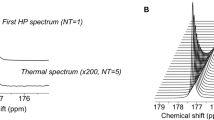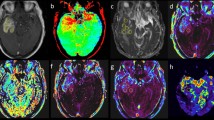Abstract
Purpose
To investigate the biochemical origin of the amide photon transfer (APT)-weighted hyperintensity in brain tumors.
Procedures
Seven 9 L gliosarcoma-bearing rats were imaged at 4.7 T. Tumor and normal brain tissue samples of equal volumes were prepared with a coronal rat brain matrix and a tissue biopsy punch. The total tissue protein and the cytosolic subproteome were extracted from both samples. Protein samples were analyzed using two-dimensional gel electrophoresis, and the proteins with significant abundance changes were identified by mass spectrometry.
Results
There was a significant increase in the cytosolic protein concentration in the tumor, compared to normal brain regions, but the total protein concentrations were comparable. The protein profiles of the tumor and normal brain tissue differed significantly. Six cytosolic proteins, four endoplasmic reticulum proteins, and five secreted proteins were considerably upregulated in the tumor.
Conclusions
Our experiments confirmed an increase in the cytosolic protein concentration in tumors and identified several key proteins that may cause APT-weighted hyperintensity.




Similar content being viewed by others
References
Stupp R, Mason WP, van den Bent MJ et al (2005) Radiotherapy plus concomitant and adjuvant temozolomide for glioblastoma. N Engl J Med 352:987–96
Chang SM, Nelson S, Vandenberg S et al (2009) Integration of preoperative anatomic and metabolic physiologic imaging of newly diagnosed glioma. J Neuro-Oncol 92:401–15
Wen PY, Macdonald DR, Reardon DA et al (2010) Updated response assessment criteria for high-grade gliomas: response assessment in neuro-oncology working group. J Clin Oncol 28:1963–72
Zhou J, Payen J, Wilson DA et al (2003) Using the amide proton signals of intracellular proteins and peptides to detect pH effects in MRI. Nature Med 9:1085–90
Zhou J, Lal B, Wilson DA et al (2003) Amide proton transfer (APT) contrast for imaging of brain tumors. Magn Reson Med 50:1120–6
Kauppinen RA, Kokko H, Williams SR (1992) Detection of mobile proteins by proton nuclear magnetic resonance spectroscopy in the guinea pig brain ex vivo and their partial purification. J Neurochem 58:967–74
Salhotra A, Lal B, Laterra J et al (2008) Amide proton transfer imaging of 9 L gliosarcoma and human glioblastoma xenografts. NMR Biomed 21:489–97
Grossman R, Tyler B, Brem H et al (2012) Growth properties of SF188/V+ human glioma in rats in vivo observed by magnetic resonance imaging. J Neuro-Oncol 110(3):315–23
Zhou J, Blakeley JO, Hua J et al (2008) Practical data acquisition method for human brain tumor amide proton transfer (APT) imaging. Magn Reson Med 60:842–9
Wen Z, Hu S, Huang F et al (2010) MR imaging of high-grade brain tumors using endogenous protein and peptide-based contrast. NeuroImage 51:616–22
Zhao X, Wen Z, Zhang G et al (2013) Three-dimensional turbo-spin-echo amide proton transfer MR imaging at 3-Tesla and its application to high-grade human brain tumors. Mol Imaging Biol 15:114–22
Zhou J, Tryggestad E, Wen Z et al (2011) Differentiation between glioma and radiation necrosis using molecular magnetic resonance imaging of endogenous proteins and peptides. Nature Med 17:130–4
Hong X, Liu L, Wang M et al (2014) Quantitative multiparametric MRI assessment of glioma response to radiotherapy in a rat model. Neuro Oncol 16:856–67
Sagiyama K, Mashimo T, Togao O et al (2014) In vivo chemical exchange saturation transfer imaging allows early detection of a therapeutic response in glioblastoma. Proc Natl Acad Sci U S A 111:4542–7
Burger PC, Dubois PJ, Schold SC et al (1983) Computerized tomographic and pathologic studies of the untreated, quiescent, and recurrent glioblastoma-multiforme. J Neurosurg 58(2):159–69
Jia G, Abaza R, Williams JD et al (2011) Amide proton transfer MR imaging of prostate cancer: a preliminary study. J Magn Reson Imaging 33(3):647–54
Zhou J, Zhu H, Lim M et al (2013) Three-dimensional amide proton transfer MR imaging of gliomas: initial experience and comparison with gadolinium enhancement. J Magn Reson Imaging 38:1119–28
Dula AN, Arlinghaus LR, Dortch RD et al (2013) Amide proton transfer imaging of the breast at 3 T: establishing reproducibility and possible feasibility assessing chemotherapy response. Magn Reson Med 70:216–24
Togao O, Kessinger CW, Huang G et al (2013) Characterization of lung cancer by amide proton transfer (APT) imaging: an in-vivo study in an orthotopic mouse model. Plos One 8:e77019
Desmond KL, Moosvi F, Stanisz GJ (2014) Mapping of amide, amine, and aliphatic peaks in the CEST spectra of murine xenografts at 7 T. Magn Reson Med 71:1841–53
Zhao X, Wen Z, Huang F et al (2011) Saturation power dependence of amide proton transfer image contrasts in human brain tumors and strokes at 3 T. Magn Reson Med 66:1033–41
Togao O, Yoshiura T, Keupp J et al (2014) Amide proton transfer imaging of adult diffuse gliomas: correlation with histopathological grades. Neuro Oncol 16:441–8
Chen W, Hu J (1999) Mapping brain metabolites using a double echo-filter metabolite imaging (DEFMI) technique. J Magn Reson 140:363–70
van Zijl PCM, Zhou J, Mori N et al (2003) Mechanism of magnetization transfer during on-resonance water saturation. A new approach to detect mobile proteins, peptides, and lipids. Magn Reson Med 49:440–9
Zhou JY, Yan K, Zhu H (2012) A simple model for understanding the origin of the amide proton transfer MRI signal in tissue. Appl Magn Reson 42(3):393–402
Westermeier R, Naven T (2002) Proteomics in practice. Wiley-VCH, Weinheim
He QY, Chiu JF (2003) Proteomics in biomarker discovery and drug development. J Cell Biochem 89(5):868–86
Zhu H, Bilgin M, Snyder M (2003) Proteomics. Annu Rev Biochem 72:783–812
Stoeckli M, Chaurand P, Hallahan DE, Caprioli RM (2001) Imaging mass spectroscopy: a new technology for the analysis of protein expression in mammalian tissues. Nature Med 7:493–6
Hobbs SK, Shi G, Homer R et al (2003) Magnetic resonance imaging-guided proteomics of human glioblastoma multiforme. J Magn Reson Imag 18:530–6
Li J, Zhuang Z, Okamoto H et al (2006) Proteomic profiling distinguishes astrocytomas and identifies differential tumor markers. Neurology 66:733–6
Shen J, Behrens B, Wistuba II et al (2006) Identification and validation of differences in protein levels in normal, premalignant, and malignant lung cells and tissues using high-throughput Western array and immunohischemistry. Cancer Res 66:11194–206
Yan K, Fu Z, Van Eyk J, Wang S, Zhou J, editors. Identification of endogenous proteins correlated with amide proton transfer (APT) imaging contrast using proteomic analysis. Proc 19th Annual Meeting ISMRM; 2011; Montreal.
Tabuchi K, Moriya Y, Furuta T et al (1982) S-100 protein in human glial tumours. Qualitative and quantitative studies. Acta Neurochir (Wien) 65(3–4):239–51
Iwadate Y, Sakaida T, Hiwasa T et al (2004) Molecular classification and survival prediction in human gliomas based on proteome analysis. Cancer Res 64(7):2496–501
Odreman F, Vindigni M, Gonzales ML et al (2005) Proteomic studies on low- and high-grade human brain astrocytomas. J Proteome Res 4(3):698–708
Zhang RL, Tremblay TL, Mcdermid A et al (2003) Identification of differentially expressed proteins in human glioblastoma cell lines and tumors. Glia 42(2):194–208
Palkovits M (1973) Isolated removal of hypothalamic or other brain nuclei of the rat. Brain Res 59:449–50
Jacobowitz DM (1974) Removal of discrete fresh regions of the rat brain. Brain Res 80(1):111–5
Xu J, Zaiss M, Zu Z et al (2014) On the origins of chemical exchange saturation transfer (CEST) contrast in tumors at 9.4 T. NMR Biomed 27:406–16
Quesson B, Bouzier A-K, Thiaudiere E et al (1997) Magnetization transfer fast imaging of implanted glioma in the rat brain at 4.7 T: interpretation using a binary spin-bath model. J Magn Reson Imag 7:1076–83
Heo H-Y, Zhang Y, Lee D-H, et al. (2014) Quantitative assessment of amide proton transfer (APT) and nuclear Overhauser enhancement (NOE) imaging with extrapolated semi-solid magnetization transfer reference (EMR) signals: Application to a rat glioma model at 4.7 T. Magn Reson Med In press.
Howe FA, Barton SJ, Cudlip SA et al (2003) Metabolic profiles of human brain tumors using quantitative in vivo 1H magnetic resonance spectroscopy. Magn Reson Med 49:223–32
Zhou J, Hong X, Zhao X et al (2013) APT-weighted and NOE-weighted image contrasts in glioma with different RF saturation powers based on magnetization transfer ratio asymmetry analyses. Magn Reson Med 70:320–7
Hua J, Jones CK, Blakeley J et al (2007) Quantitative description of the asymmetry in magnetization transfer effects around the water resonance in the human brain. Magn Reson Med 58:786–93
Griffiths JR (1991) Are cancer cells acidic? Br J Cancer 64:425–7
Acknowledgments
The authors thank Drs. Silun Wang and Bachchu Lal for experimental assistance and Ms. Mary McAllister for editorial assistance. This work was supported in part by grants from the National Institutes of Health (R01EB009731, R01CA166171, R01NS083435, R21EB015555, P30CA006973, and HHSN268201000032C).
Conflict of Interest
None of the authors has any conflict of interest.
Author information
Authors and Affiliations
Corresponding author
Electronic supplementary material
Below is the link to the electronic supplementary material.
ESM 1
(PDF 752 kb)
Rights and permissions
About this article
Cite this article
Yan, K., Fu, Z., Yang, C. et al. Assessing Amide Proton Transfer (APT) MRI Contrast Origins in 9 L Gliosarcoma in the Rat Brain Using Proteomic Analysis. Mol Imaging Biol 17, 479–487 (2015). https://doi.org/10.1007/s11307-015-0828-6
Published:
Issue Date:
DOI: https://doi.org/10.1007/s11307-015-0828-6




